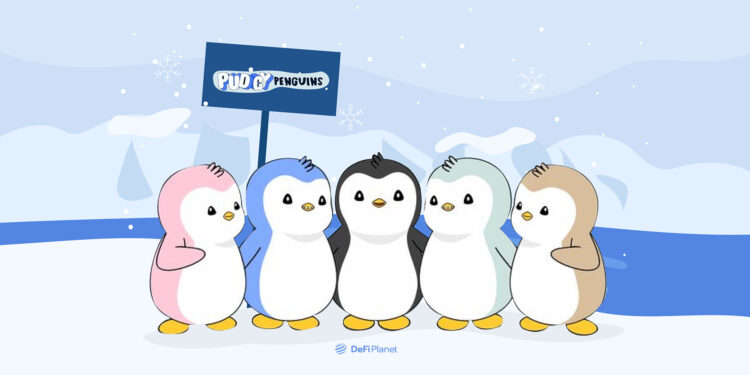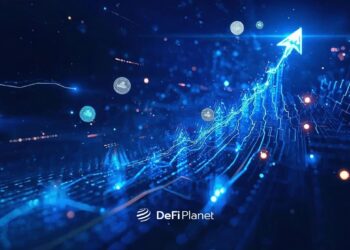Pudgy Penguins is another NFT project that has captured the crypto community’s attention, similar to big players like CryptoPunks, Bored Ape Yacht Club, and Azuki.
This project has a rather interesting story of rising, falling and rising again within a space of 3 years of its existence.
The Pudgy Penguins NFT collection, which comprises 8,888 penguin avatar NFTs on the Ethereum blockchain, was launched on July 23, 2021, impressively selling out in under 20 minutes without any pre-launch marketing…all purely word-of-mouth and social media.
Each Penguin NFT sold for 0.03 ETH (about $100), and at press time, the project’s listings have a floor price of at least 10 ETH and a market cap exceeding 97.3 ETH.
What makes Pudgy Penguins so unique? How did the project start? What happened when it collapsed? How did Luca Netz revive the project? This article explores these questions and more.
The Troubled Beginnings of the Pudgy Penguins Project
Cole Villemain and a team of anonymous creators – Fluffster, Pengo, Waddles, and Snowy – aimed to create a unique NFT collection inspired by projects like CryptoPunks and Bored Ape Yacht Club.
Choosing penguins as their theme because of the bird’s conventional association with “empathy, happiness, compassion, and love”, the team combined code and art to give each penguin individual traits that defined its personality, style, and rarity.
The project officially began in July 2021 with the release of 8,888 NFTs priced at 0.03 ETH each. Unfortunately, the project encountered difficulties soon after its launch.
The Fall: Rug Pull Accusations Against Pudgy Penguins Founders.
The decline of the Pudgy Penguins project began in December 2021, when its community moderator, Darth, publicly left, criticizing the founders for their “unprofessional” conduct. .
There were claims of a disagreement regarding Darth’s promotion to community manager, and Villemain supposedly offered 1 ETH to keep things quiet. Notably, Villemain had been previously linked to other projects that were rug-pulled.
The following month, NFT influencer 9x9x9 claimed that the founders were attempting to sell the project after taking all its funds and mentioned rejecting an offer to purchase the project for 888 ETH.
Following these developments, numerous Pudgy Penguin holders withdrew their support for the project’s founders, and the project began a downward spiral in relevance. But it wasn’t for long.
Luca Netz Acquisition and Transformation
Despite these events, entrepreneur Luca Netz saw promise in the troubled project and bought it for $2.5 million in April 2022 through Netz Capital. This acquisition became pivotal for Pudgy Penguins, bringing a fresh sense of direction and leadership.
Netz took charge as CEO, steering a period of notable advancement and change. He carefully secured licensing agreements to create physical toys from the NFTs, expanding the project’s influence.
Netz’s acquisition of the project also saw the creation of a new team to oversee the project’s affairs. The new team, with members like Nicholas Ravid (CMO), Lorenzo Melendez (CTO), Peter Lobanov (CCO), Dr Kaizu (COO), and Jennifer McGlone (CLO), were able to build the project into a notable success story in the crypto world that it is today.
The Penguins gained significant popularity during the 2022 Christmas season, and a subsequent $9 million seed funding round, led by 1kx, a firm that invests in the early stages of developing ecosystems, strengthened its position as an intellectual property brand.
By the close of 2022, Pudgy Penguins NFTs witnessed a notable rise in minimum price, surpassing previous highs. This prosperous trend continued into 2023, as the project consistently held a position within the top 20 for monthly trading volumes on OpenSea.
The Pudgy Penguins Ecosystem
Aside from the initial Pudgy Penguins NFT collection, other related projects are thriving within its domain, together constituting the Pudgy Penguins ecosystem. Notable projects within this ecosystem include:
Pudgy Toys
In collaboration with PMI Toys, Pudgy Penguins ventured into the physical realm by bringing their NFTs to life as tangible toys. This partnership unlocks exciting licensing opportunities for NFT holders but also spreads joy by materializing Pudgy Penguins in the form of toys.
Presently, Pudgy Toys are available in 2,000 Walmart stores across the United States. The toy designs feature elements from widely known NFT collections like DeGods and Meebits. They are distributed in a way that guarantees that current NFT holders receive licensing royalties for each corresponding toy sold.
Lil Pudgys
Lil Pudgys are a collection of 22,222 unique NFTs that complement the Pudgy Penguins. The collection is based on the Ethereum blockchain and provides a budget-friendly entry point into the Pudgy Penguins universe.
Out of the total collection, 8,000 NFTs are reserved for existing Pudgy Penguin NFT holders.
Pudgy Rods
Pudgy Rods is another NFT collection within the ecosystem. They were initially air-dropped to the holders of the original Puddy Penguins on August 30, 2021.
However, there is some uncertainty about the value and significance of these NFTs due to a spelling mistake in their name. Instead of “rods,” they were mistakenly spelt as “rogs.” Despite this, some believe that they may have some value as assets in a forthcoming Pudgy Penguins-related game.
truePengu
“truePengu” is a token that was introduced on July 22, 2022, to celebrate the project’s first anniversary. The token is “soulbound,” meaning that it is permanently tied to the wallets of its holders. It was used to categorize holders into different tiers based on their holdings and to reward them for owning the original NFTs and other NFTs within the ecosystem.
There were several variations of these tokens, and each participant in the ecosystem received a variation based on their holdings. Those who possessed Pudgy Penguins, Lil Pudgys, and Pudgy Rods were rewarded with Ice, Iridescent, and Gold-styled truePengus, respectively.
penguPins
penguPins is the project’s second Soulbound token. It was introduced on August 12, 2022, to identify individuals actively contributing to Pudgy Penguins’ initiatives. Each wallet holding the licensing rights for their Penguins in the physical toy collaboration with PMI Toys received sixteen penguPins.
Pudgy Bridge
The Pudgy Bridge is a tool that allows users to move Pudgy Penguins NFTs between Ethereum and Polygon blockchains. This bridge increases the ease and flexibility of interacting with Pudgy Penguins in various ecosystems. It allows users to take advantage of both networks’ strengths: Ethereum’s security and Polygon’s lower transaction fees.
What Makes Pudgy Penguins Unique
The captivating narrative of Pudgy Penguins, which had a troubled start but transformed into a successful NFT project, is an excellent example of how NFTs can revolutionize the digital art and collectibles landscape.
The growth strategy designed by Netz and his team to expand the Pudgy Penguins brand beyond the NFT ecosystem is quite fascinating. It focuses on long-term sustainability and community involvement and establishes a new standard in Web3 to appeal to those who are sceptical about blockchain technology.
Pudgy Penguins’ innovation lies in connecting digital NFTs with physical toys. Unlike other NFT collections, which limit their exclusivity to the digital realm, Pudgy Penguins ventures into the physical domain with its toy line.
Exploring the link between digital NFTs and physical toys reveals positive user responses and excitement surrounding the tangible manifestation of digital assets. These physical toys offer additional revenue streams for NFT holders through licensing royalties, broadening the project’s economic ecosystem.
The physical connection also makes the project more accessible to individuals who are not fully immersed in the digital NFT space, potentially attracting a wider audience. It also showcases an inventive use of intellectual property (IP) in Web3, setting a precedent for others to follow.
However, as with any innovative venture, there are both benefits and potential drawbacks. Managing the production and distribution of physical toys introduces logistical complexities that may pose challenges to the project. Extending the brand beyond the digital space may dilute its exclusivity, potentially impacting the perceived value of the digital NFTs.
In essence, Pudgy Penguins’ foray into the physical toy realm reflects a bold and innovative approach. While the community’s response has been largely positive, the project must navigate potential challenges to ensure a harmonious integration of the digital and physical aspects, maintaining the intrinsic value of the NFTs while expanding its reach.
The future success of Pudgy Penguins and similar NFT projects is uncertain, but it will be intriguing to observe how their fundamental values are maintained.
Quoting the project’s post on its official X account: “These collectibles, alongside our Pudgy Plushies, are only a sneak peek of the diverse line of toys in our collection. As we continue to bring the Pudgy Penguins to life, we are ecstatic to be at the forefront of IP utilization in Web3. Stay tuned for what’s next.”
Read more about the NFT ecosystem >>> NFTs in 2023; Reboot, Resurgence or Resting-in-Peace
Disclaimer: This article is intended solely for informational purposes and should not be considered trading or investment advice. Nothing herein should be construed as financial, legal, or tax advice. Trading or investing in cryptocurrencies carries a considerable risk of financial loss. Always conduct due diligence.
If you would like to read more articles (news reports, market analyses) like this, visit DeFi Planet and follow us on Twitter, LinkedIn, Facebook, Instagram, and CoinMarketCap Community.
“Take control of your crypto portfolio with MARKETS PRO, DeFi Planet’s suite of analytics tools.”





















